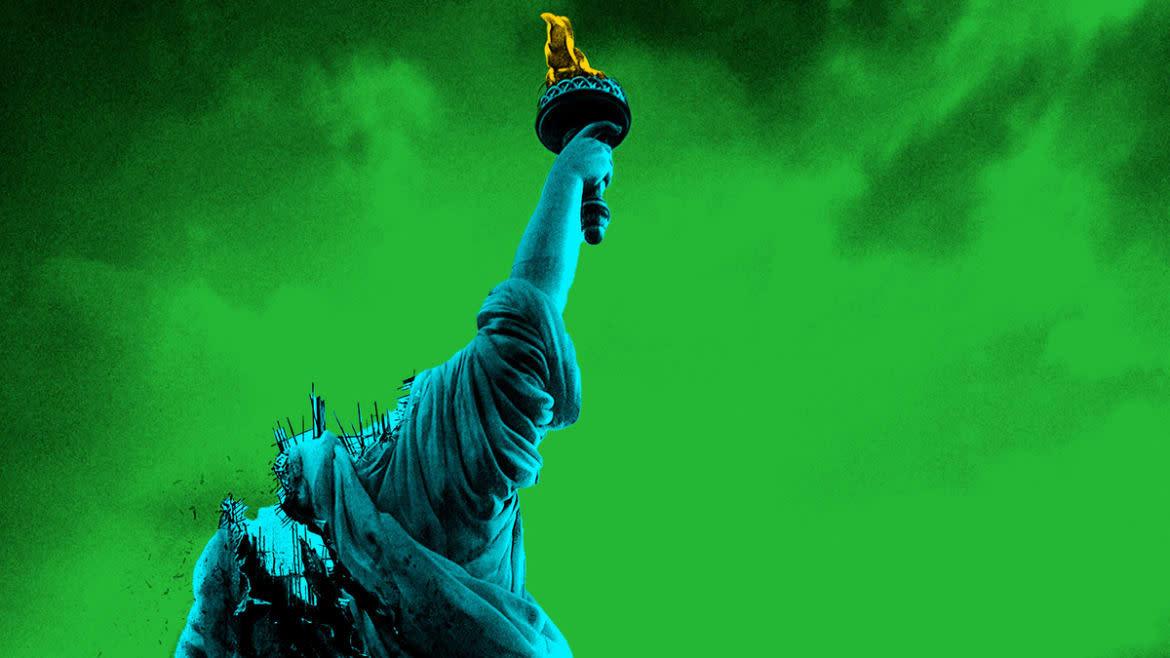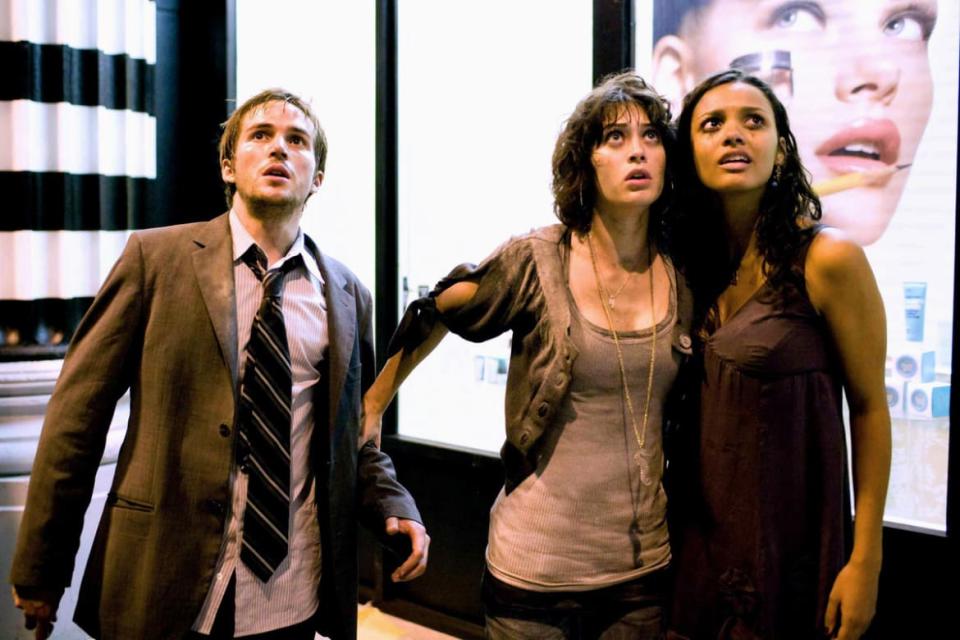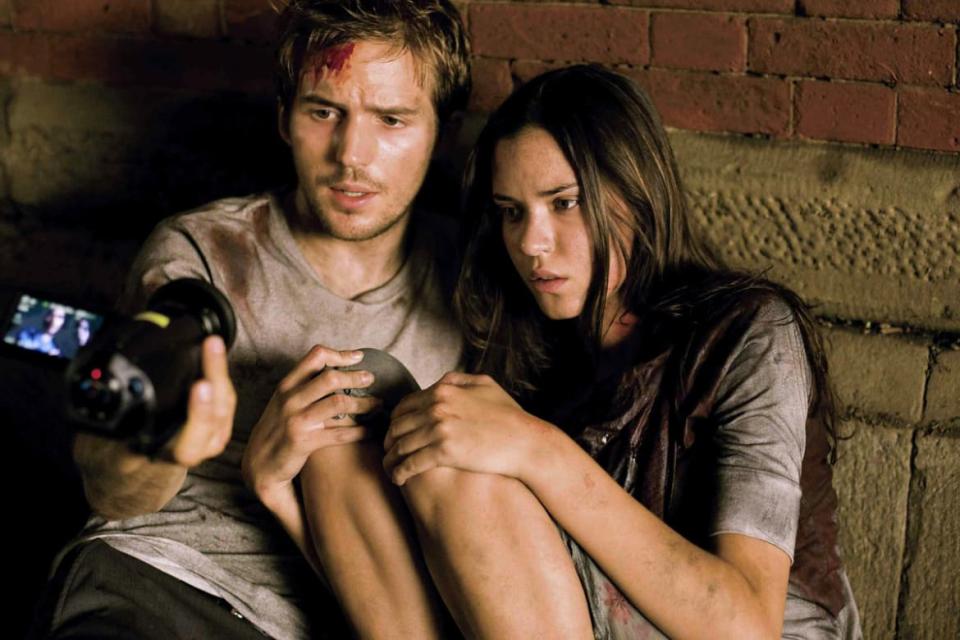‘Cloverfield’ Is (Still) the Best Monster Movie Ever Made

- Oops!Something went wrong.Please try again later.
- Oops!Something went wrong.Please try again later.
- Oops!Something went wrong.Please try again later.
Fifteen years ago today, some thing attacked New York City. No, I don’t mean Lady Gaga at the start of the first year of her meteoric rise to fame, though that certainly caused its own type of colossal destruction—to my bank account! (Finish throwing your tomatoes, then we can continue.) I’m talking about the four-legged, 25-story-tall beast that rampaged through Manhattan in the movie Cloverfield, which landed in theaters Jan. 18, 2008.
If you’re a colossal monster movie nerd like myself, 1-18-08 is a hallowed date, and it has been since before Cloverfield even made its theatrical debut. It seems like several lifetimes ago, but try to think back to when Transformers was the biggest film in the world and Shia LaBeouf wasn’t a flight risk. Audiences packed themselves into theaters for the first Transformers film in early July 2007. But before the movie started, they were first treated to a mysterious teaser trailer.
Scenes of a surprise party in New York City, filled with hipster yuppies talking to a handheld camera, were spliced together over late-aughts pop hits: friends wishing some guy named Rob good luck in Japan; Lizzy Caplan appearing in a major motion picture for the first time since Mean Girls infiltrated the cultural lexicon forever. Suddenly, the floor shakes, the lights go out, and a thunderous roar permeates the air. The partygoers make their way up to the roof just in time for an explosion of fireballs to come hurtling toward them. A frantic rush down the stairs and into the street is met with familiar scenes of New Yorkers running in one direction before the Statue of Liberty's head is thrown, crashing into the frame. The teaser ends with no title, only a release date: 1-18-08.
The trailer instantly lit up message boards (remember those?) with speculation. What the hell was this movie, and what the hell was happening in that trailer? Just shy of six years post-9/11, Cloverfield’s teaser ingeniously rode in on the fumes of fear that still permeated American culture.
That short preview replicated the effect of repeatedly seeing footage of fiery explosions and collapsing buildings after 9/11, to a macabre but intriguing effect. It was the first piece of one of the best and most innovative marketing campaigns of the millennium so far, which hooked millions of people into its viral alternate reality game (“ARG,” for short) and brought the film unprecedented success for a January theatrical release. Cloverfield didn’t just give American millennials our own iconic monster, predicated on cultural history and anxieties. It created an experience that has to be seen to be believed, a love story and monster movie rolled into one horrific package.

It was four months after its teaser trailer’s release before the public even knew Cloverfield’s title, when a full trailer hit theaters ahead of Beowulf. In that time, self-appointed sleuths had already dug up strategically placed websites around the internet (most of which are now defunct) and MySpace profiles that contained clues toward the film’s backstory and character traits. The sites were regularly updated by the film’s campaign managers until a few weeks following its theatrical release, and audiences could use them to fill in the story if they wanted more answers—they certainly weren’t going to get them from the movie itself.
Because Cloverfield is a found-footage film, what we see is what we get. The only exposition comes in the form of the film’s opening scenes, which depict its central characters, close friends Rob (Michael Stahl-David) and Beth (Odette Annable), filming each other the morning after a hookup. The film then cuts to months later, when Rob’s brother, Jason (Mike Vogel), begins accidentally taping over the footage to capture Rob’s goodbye party that night. There are only 18 minutes of footage before the monster emerges from the depths of the Atlantic, and the night goes haywire.
By bucking the conventions of your standard monster movie, producer J.J. Abrams, director Matt Reeves, and writer Drew Goddard thrust audiences directly into action in a way that hadn’t been done before on such a grand scale. Your average monster movie is going to fall back on 45 minutes of storytelling before anything interesting starts happening. But Cloverfield’s found-footage style allows the film to be free of any obligation to explain things to the audience using a normal narrative structure. Instead, we feel like spectators on the ground, witnessing all of the events firsthand, just as confused and terrified as all of the characters.
‘Skinamarink’: The Journey From $15,000 Horror Indie to Terrifying Viral Phenomenon
The moment the first attack happens, Cloverfield becomes a nonstop, pulse-pounding ride. There are no moments of reprieve, not a second to compose yourself and check in on some tertiary character somewhere else. Even the occasional, brief cuts to the footage of Rob and Beth on their date months prior—selectively placed to give the film its emotional edge—are tinged with terror knowing what we’ll cut back to. There’s nothing so sad and grisly as risking your life for love, and that’s what Rob decides to do when he and his friends traverse from downtown Battery Park to Columbus Circle to rescue Beth in the face of certain death.
One by one, they’re picked off amidst a well of confusion and discord. As the death toll rises, so does the number of monster shots. “Clover,” as fans so affectionately named the monster, is teased out slowly. Its massive tail destroys the Brooklyn bridge during an evacuation; its roaring face soars through army gunfire and dust as Rob’s crew ducks into subway tunnels. Hints of its massive scope are briefly seen on televisions being looted from electronics stores.
But it's the two scenes in the film’s final act—a grand, full-scale shot of Clover moving through Midtown seen from a helicopter, and a direct close-up in Central Park—that remain the most haunting. These shots are where it becomes clear: Clover isn’t just a monster, it’s an apocalypse.
With a country’s greatest fear playing out on the big screen, Cloverfield captured a society on the precipice of major change. Social media and civilian digital video were about to become the premier source of unfiltered news in a post-9/11 world, triggering a cultural reckoning and inescapable political division. If the original Godzilla was created as a way for Japan to grapple with the atrocities thrust onto the country in World War II, Cloverfield was the culmination of the collective American anxiety that bore into our consciousness when 9/11 made a new generation realize that safety was simply an illusion.
But the reason Cloverfield stands out as a distinct competitor to Godzilla’s iconic stature is the way it capitalizes on the way love interacts with fear as part of human nature. Godzilla—in both the 1950s and 2010s—focused heavily on creature origin stories and military responses. But Cloverfield shirks all of that to appeal to the viewers’ base-level emotions. Fear and love have been the catalysts for the greatest art ever made, and the same is true here.

Viewers showed up to see the terror of a deep sea creature rampaging through New York and were left pained by Rob and Beth’s doomed love story. The film’s final moments are a gut punch of sadness and startling humanity, imbued into the exoskeleton of a film that would otherwise be a straight-up creature feature. If you could see the person you love and look them in the eye, in what you think will be your last moments together, what would you say? The movie’s finale is unforgettable in its bleak heartache. Cities can be rebuilt, but lives are gone forever. It’s rare that a monster movie can make you give even half a shit about the human characters within it, and Cloverfield runs laps around the attempts from similar genre offerings with ease.
In just 85 minutes and on a $25 million budget, Cloverfield did what other monster movies spend two hours and millions more trying to do. It created something iconic in no time at all, and elevated our shared anxieties to the silver screen. And while its anthologized continuations have ranged from great (10 Cloverfield Lane) to horrible (The Cloverfield Paradox), the original 2008 feature still has a solid foundation to build upon. A direct sequel was announced last year, and if it ever does see the light of day, diehard fans like myself will be hoping that it can come anywhere close to replicating the first film’s intuitive scope.
Occasionally, on a gloomy January day like today, I’ll look up from the street level in Manhattan and wonder, “What if?” Of course, it seems impossible. But who knows what’s lurking out there, beneath the surface? A good monster movie scares you in the theater, but a great one makes you spend the next 15 years planning your escape. And I’ve already got the getaway routes all mapped out.
Get the Daily Beast's biggest scoops and scandals delivered right to your inbox. Sign up now.
Stay informed and gain unlimited access to the Daily Beast's unmatched reporting. Subscribe now.

